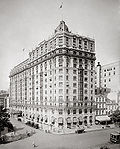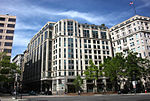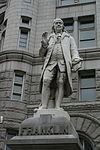Hudson Institute
1961 establishments in New York (state)Conservative organizations in the United StatesEli Lilly and CompanyForeign policy and strategy think tanks in the United StatesForeign policy political advocacy groups in the United States ... and 9 more
Futures studies organizationsHudson InstituteNeoconservatismNew Right (United States)Non-profit organizations based in Washington, D.C.Political and economic think tanks in the United StatesRAND Corporation peopleRight-wing politics in the United StatesThink tanks established in 1961

The Hudson Institute is a conservative American think tank based in Washington, D.C. It was founded in 1961 in Croton-on-Hudson, New York, by futurist Herman Kahn and his colleagues at the RAND Corporation. In January 2021, John P. Walters was appointed president and CEO of the Hudson Institute. Walters succeeded Kenneth R. Weinstein who had been CEO since June 2005 and was named president and CEO in March 2011.
Excerpt from the Wikipedia article Hudson Institute (License: CC BY-SA 3.0, Authors, Images).Hudson Institute
Pennsylvania Avenue Northwest, Washington
Geographical coordinates (GPS) Address Nearby Places Show on map
Geographical coordinates (GPS)
| Latitude | Longitude |
|---|---|
| N 38.895722222222 ° | E -77.028916666667 ° |
Address
Pennsylvania Avenue Northwest 1201
20004 Washington
District of Columbia, United States
Open on Google Maps









